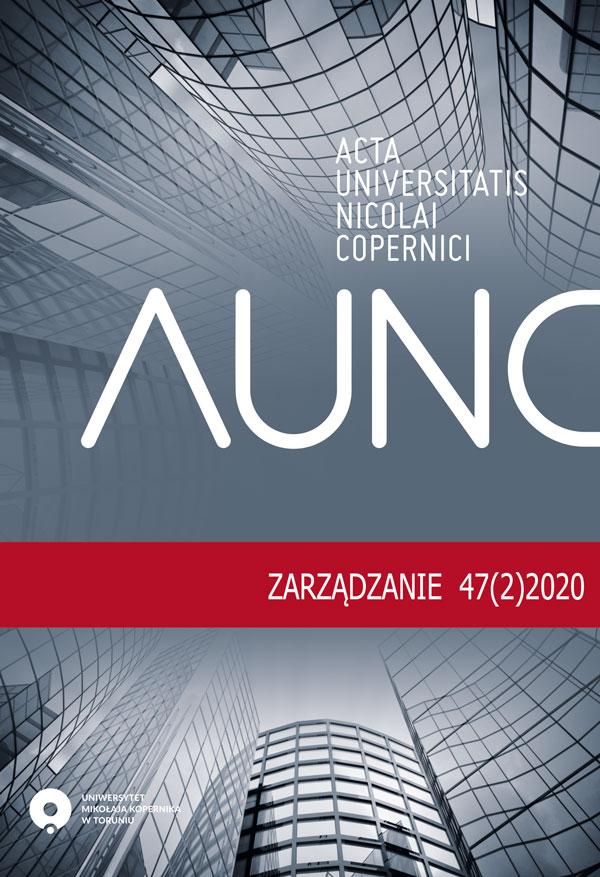MATERIAL MANAGEMENT IN A MANUFACTURING COMPANY
DOI:
https://doi.org/10.12775/AUNC_ZARZ.2020.02.006Słowa kluczowe
material management, management, inventory, supply, storageAbstrakt
Materials management in manufacturing enterprises is undoubtedly one of the most important areas of its functioning. The article aims to present the essence of the selected area and make the reader aware of its rank. The first chapter presents theoretical issues regarding the area of interest of the article. These include, among others: the supply process, its planning method, supply logistics, material management, the role of supply in material flow planning, material demand planning, material flow control methods in enterprises, purchase and supply planning in the material supply process, methods of choosing supply sources and ABC analysis in material management. The second chapter presents the company. It contains its general characteristics. Then the focus was on the characteristics of supply logistics, order planning procedure, materials management, methods and factors affecting the choice of supply sources. After analyzing the material management and analysis of the current level of inventories using the ABC method, there was an indication of problems existing in the company. The search for their causes and proposals of effective solutions began. The methods and tools that were used were: MRP method, quality circles and a carousel of ideas used in their operation, as well as cause and effect analysis using the Ishikawa diagram. Several other solutions have also been proposed. All, however, were intended to eliminate the problem. All calculations and analyzes created for the purposes of this article have been supported by company data and direct interview with employees responsible for the supply process.
Bibliografia
Bendkowski J., Radziejowska G., Logistyka zaopatrzenia w przedsiębiorstwie, Wydawnictwo Politechniki Śląskiej, Gliwice 2005.
Coccia M., The fishbone to identifity, systematize and analize the sources of general purpose technologies, ,,Journal of Social and Administrative Sciences” 2017, nr 4, s. 292-300.
Garbarski J., Rutkowski I., Wrzosek W., Marketing. Punkt zwrotny nowoczesnej firmy. Wydanie II., PWE, Warszawa 2000.
Gołembska E., Bentyn Z., Rogaczewski R., Gospodarcze konsekwencje rozwoju logistyki międzynarodowej, Wydawnictwo Uniwersytetu Ekonomicznego, Poznań 2014.
Kauf S., Płaczek E., Sadowski A., Szołtysek J., Twaróg S., Vademecum logistyki, Difin, Warszawa 2016.
Lawler III E.E., Mohrman S. A., Quality Circles After the Fad, https://hbr.org/1985/01/quality-circles-afterdostę-the-fad, dostęp: [05.03.2020].
Miller J.G., Sprague L.G., Behind the growth in Materials Requirements Planning,hbr.org/1975/09/behind-the-growth-in-materials-requirements-planning, [dostęp: 05.03.2020].
Niziński S., Żurek J., Logistyka ogólna, Wydawnictwa Kominikacji i Łączności Sp. z.o.o., Warszawa 2011.
Pomiar funkcjonowania łańcuchów dostaw, red. D. Kisperska- Moroń, Wydawnictwo Akademii Ekonomicznej w Katowicach, Katowice 2006.
Porter M.E., Strategia konkurencji. Metody analizy sektorów i konkurentów, PWE, Warszawa 1992.
Skowronek Cz., Sarjusz- Wolski Zdz., Logistyka w przedsiębiorstwie, PWE, Warszawa 1999.
Pobrania
Opublikowane
Jak cytować
Numer
Dział
Statystyki
Liczba wyświetleń i pobrań: 594
Liczba cytowań: 0







